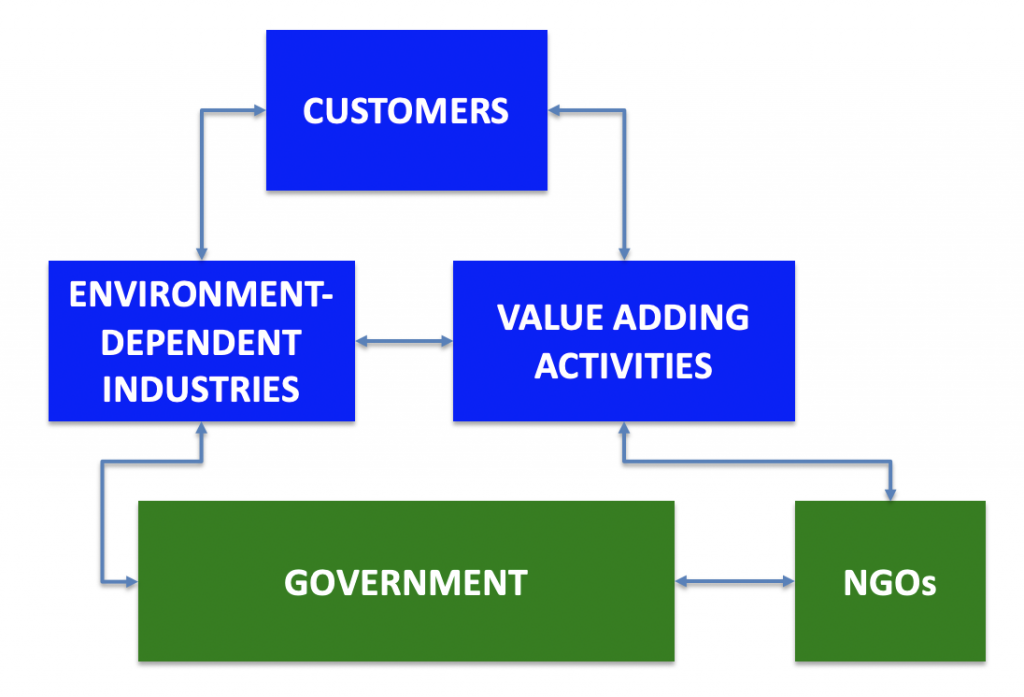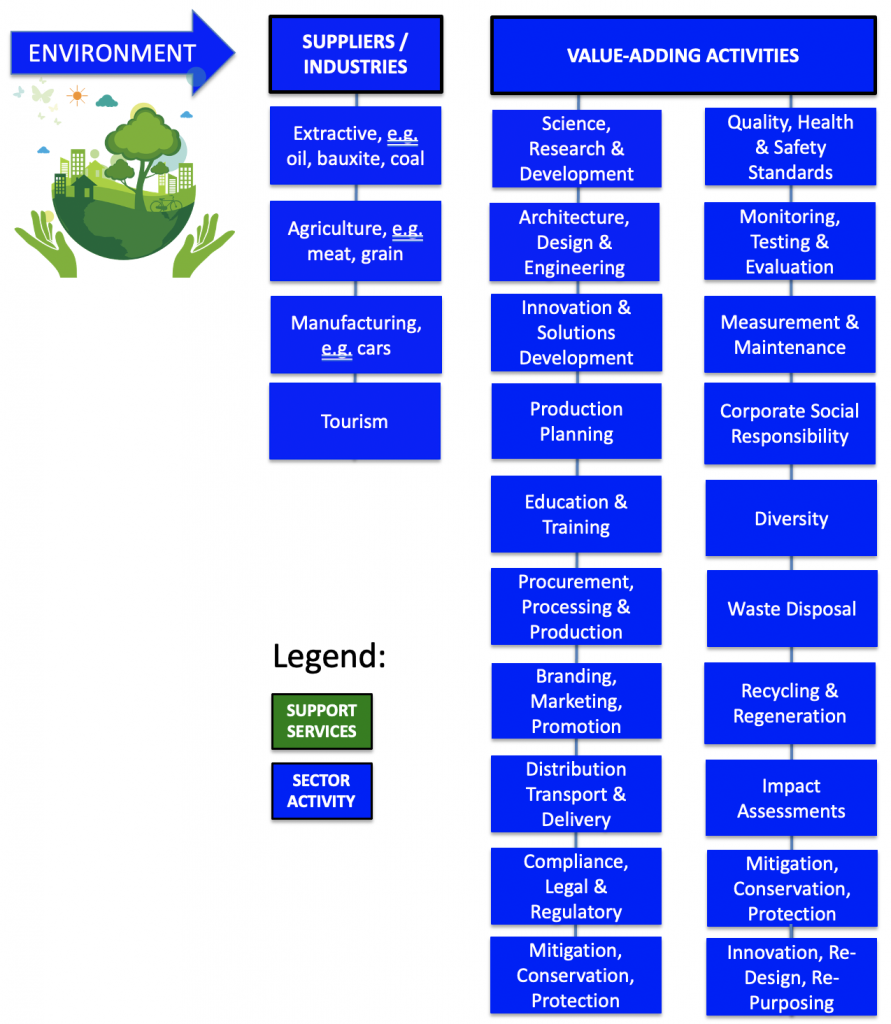
Our Environment is the Biggest Industry in the World – Here’s How you can Benefit
Everything we do, everything we eat, everything we breathe and everything we are is related to the environment. Extractive Industries such as bauxite (used to make aluminium), oil (needed to fuel everything in life and to make plastics); coal (used for energy and steel); iron ore (to make iron); gold (for jewelry and to store value); diamonds (for the love industry); rare earth (for the electronics industry); cobalt (to make batteries); trees (to make furniture); lithium (for batteries); land (for agriculture and housing); wind and water (for power). In addition, the environment (land) sustains a massive agriculture industry and the seas, an enormous fishing industry as well. Is it clear now that we can do almost nothing – live, love, transport, eat and sleep – without the environment?

Everything that we Humans Do and Everything that we are Destroys the Environment
Is it clear by now that everything that we do, and everything that we are, contrive to destroy then environment. It took an IPPCC 2021 ‘discover’ that it is HUMANS that are destroying the environment. But everything that we do, and everything that we could be, can also sustain a healthy and wholesome environment.

The Numbers are Staggering
– 10 billion Humans in the world by 2050
– 70% of all Wildlife destroyed in the 50 years from 1971 to 2021
– 94% of all Animals on Earth are Edible Livestock
– 80% of all Forests have been destroyed
– 80% of all marine life destroyed.
Yes, the world is in dire straits. And it would not be able to sustain itself unless massive measures are taken. To understand what measures can be taken, and how economies and societies can benefit from reversing these destructive trends, it is important to understand the value chain of the environment. This helps us to understand where and how one should intervene to reduce or eliminate/reduce/mitigate destruction
The environment value chain (EVC) also shows us how and where profits can be made from saving Planet Earth. It also shows us the areas and avenues available for reducing negative environmental impacts.
The Value Chain of the Environment (EVC) is Enormous
The environment is under serious threat, but there are even bigger opportunities in making it better. The Value Chain of the Environment (EVC) is Enormous.

There are many ways of looking at a value chain. We will look at the environmental value chain for five vantage points:
- Customers that buy final products,
- Suppliers/Producers/Manufacturers that are the primary users of the environment
- The skills/techniques associated with production, innovation, monitoring and mitigation
- Governments that provide enabling environments
- NGOs that help to engage and involve local communities and civil society


1. Growing Conscious and Environmentally Friendly Customers
Let’s start with the CUSTOMERS. Customers are us, the ones with the buying power that literally determine what and how should be produced and what satisfies our needs, wants and dreams best. Of course, some of the most successful companies today are in the business of supplying us with what we do not even as yet know we want[1].
Customers today are more in the know, more knowledgeable, more demanding, more picky, more environmentally friendly than ever before. These Almighty Customers (ACs) are definitely calling the shots[2]. It is really the battle for customers’ attention, time (and money) that we are seeing play out, with the winners (Google, Facebook, TenCent) taking it all.
One can start from extraction, procurement, design, development, production, validation and the final customer.
2. Environment and Resource-Users – Producers Industries and Sectors
Producers, industries and sectors of the economy are all users of the environment. Almost every ‘good’ that we produce uses, depletes or harms the environment in some form or fashion. The environment is pressured from extractive industries (coal, bauxite, limestone, aggregates, iron ore, gold, diamond, oil, natural gas, rare earth, cobalt) to down-stream processors (steel, aluminium, plastics) that goes in every consumers’ ‘white goods’ (e.g. appliances) and mobile phones and more.
3. Value-Adding Activities
Here, enormous wealth is created both through further environmental destruction as well as from conservation and mitigation activities. Value-adding activities involve a variety of skills and competences that are growing in importance. Such include, but are not limited to:
• Science, research and development
• Architecture, design & engineering
• Innovation & solutions development
• New technologies
• Extraction
• Production planning
• Education & Training
• Finance
• Construction & commissioning
• Processing
• Production
• Procurement
• Packaging
• Branding, marketing, promotion
• Social Media
• Distribution
• Transport & delivery
• Compliance, legal & regulatory
• Quality, health & safety standards monitoring, testing,
• Evaluation, measurement, maintenance,
• Corporate Social responsibility
• Diversity
• Waste disposal
• Recycling & regeneration, impact assessments,
• Mitigation, conservation, protection
• Innovation, re-design, re-purposing, re-generation & sustainable development
4. Government – Create the Enabling Environment
Governments provide the enabling environment that ideally allows and facilitates sustainable development and production activities. Such value-adding activities of governments include:
• Rules & Regulations
• Laws and Legal Framework
• Incentives
• Taxes
• Fines
• Fees
• Royalties
• Negotiations
• Transparency
• Finance & Investments
• Measuring & Monitoring
5. Non-Governmental Organisations – A Vital Link
NGOs support the efforts of the government through reaching and providing a voice for those that have most to lose and most to benefit from a destroyed environment. NGOs operate in many areas and provide considerable benefits. They are an important key in the environmental destruction/conservation value chain. They provide support to the value chain through lobbying, activism, advocacy and awareness building. They also provide capacity building and technical and funding support. Environmental NGOs are also instrumental in monitoring and evaluating activities that have environmental impacts.
Here’s How you Can Benefit
It is clear that all industries involve and use the environment in some way.
Engaging with and focusing on the value-creating activities are key – firm science and technology, research and development. Education and training, production, planning, commissioning and much more. Focus on the value-creating activities within the environment value chain (EVC).
Author
Dr. Auliana Poon

Dr. Auliana Poon is the founder and Managing Director of Leve Global and Exceptional Caribbean.
Auliana loves the Caribbean and believes in its people. Her personal mission is to change the world; to transform our societies. And this is precisely why she has spearheaded Exceptional Caribbean – a continuing mission to elevate tourism, trade and lives.
Here are Related Articles That Might Also Interest You
![]()




Certainly, the biggest threats to our Caribbean environment are the extractive industries such as Bauxite/Alumina which practices strip mining and Limestone mining as well as the lumber Industry which have destroyed a significant portion of the forests in Jamaica, Guyana and Belize in particular. The Bauxite mining in Jamaica is now threatening the Cockpit Country and thousands of small farmers and the homes of people who have lived in surrounding areas for eons. There needs to be a serious assessment of these industries as they currently are the greatest destroyers of our natural environment.